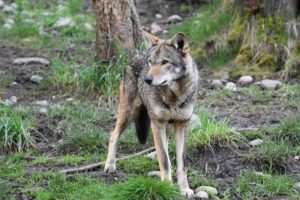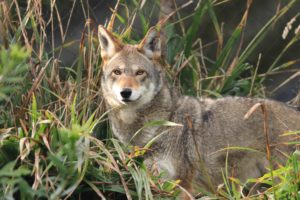Red Wolf Pups Arrive
TACOMA, Wash. – Happy Mother’s Day, indeed.
Four healthy red wolf pups were born at Point Defiance Zoo & Aquarium between 1 and 4 p.m. Friday afternoon, the first litter of the critically endangered species born at the zoo since 2012.
They are the offspring of 4-year-old Charlotte and 6-year-old Hyde.

Dad Hyde was among several pups born in that litter at the zoo several years ago.
The births represent another success in an effort established at Point Defiance Zoo in 1973 to save the extremely fragile species from extinction.
They are one of the most endangered species of wolf on the planet.
“We are thrilled to have red wolf pups at Point Defiance Zoo & Aquarium again,” said Metro Parks Tacoma Board of Commissioners President Aaron Pointer. “The pups represent the future of this critically endangered species, and we are proud of the role Point Defiance Zoo has played in saving these beautiful animals from extinction.”

Charlotte whelped the pups in the zoo’s Red Wolf Woods habitat beginning at about 1 p.m. on Friday. They likely will remain out of public view with mom for several weeks while they rest and nurse and grow, said Natalie Davis, Point Defiance Zoo & Aquarium’s Land Animal Curator. Davis also is a member of the Association of Zoos & Aquariums Species Survival Plan® Management Team for red wolves and the Red Wolf SSP studbook keeper.
Charlotte’s DNA is valuable to maintaining genetic diversity among the red wolf population in North America, Davis said.
“It’s important for us to contribute to red wolf breeding efforts here at the zoo,” said General Curator Karen Goodrowe, who holds a doctorate in reproductive physiology. “The births provide a remarkable opportunity for our visitors to connect with this species and for all of us to aid in their conservation.”
Although they’re the first red wolves born on zoo grounds in seven years, the program has produced hundreds of pups at off-site breeding facilities since its inception.
Red wolf pups typically weigh about 1 pound each at birth, Davis said. These pups won’t get formal weights and health checks from the zoo’s veterinary team for a few days. Zoo staff is giving the new family time to bond.
Video from a camera placed in the Red Wolf Woods den box shows Charlotte to be an attentive mother, licking and grooming the squirming newborns as they make high-pitched woofing sounds, even as they nurse.
Charlotte can be reserved at times and “goofy” with her play behavior in the zoo’s Red Wolf Woods habitat at others, Davis said. She described dad Hyde as a “very handsome” wolf who earned his name because of his shyness while growing up at the zoo. All of the pups from the 2012 litter were given the names of counties in North Carolina, part of the wolves’ native range in the Southeastern United States. The county name Hyde fit the shy pup who tended to spend time off in the shadows by himself, she said.
The births will again put the spotlight on a program that’s a true success story in animal population breeding and recovery. The first litter of pups in the red wolf recovery program was born at the zoo in 1977; this year marks the 42nd anniversary of that event.
Those births were the watershed moment in the recovery of the species.
By the 1970s, a scant 14 red wolves were all that remained of the once populous species. In 1980, the U.S. Fish and Wildlife Service declared the red wolf biologically extinct in the wild.
Today, some 40 roam the Red Wolf Recovery Area operated by the U.S. Fish & Wildlife Service in northeastern North Carolina. And they are threatened by a number of environmental and human factors. It’s a scant number, considering that hundreds of wolves once lived in a wide swath across the Southeastern United States.
Red wolves were first reintroduced to the wild three decades ago.
The breeding and recovery program is a cooperative effort among 42 U.S. zoos and wildlife centers and the Fish & Wildlife Service.
There are approximately 257 adults and juveniles at the cooperating facilities, including 31 pups born so far during this breeding season.
The zoo’s leadership has been extensive and unwavering through the years.
Metro Parks Tacoma’s dedication to bringing this iconic American species back from the brink of extinction has been lauded by partners, peers and wildlife conservationists as extraordinary. Since the program’s inception, about one third of pup births have occurred at Metro Parks facilities. Metro Parks staff currently cares for about one quarter of the program’s population.
Helping to preserve the imperiled species dovetails well with the zoo’s core values of conservation and preservation, said Alan Varsik, Director of Zoological & Environmental Education for Metro Parks Tacoma.
“The Red Wolf Recovery Program is living proof that zoo-based endangered species breeding programs can successfully bring a species back from the brink of extinction,” Varsik said. “This is another wonderful example of the role zoos can play in conservation efforts at home and around the world.”
###
Point Defiance Zoo & Aquarium, the Northwest’s only combined zoo and aquarium, practices and promotes responsible stewardship of the world’s resources. A member of the Metro Parks Tacoma family, the zoo creates a legacy of sustainability for future generations through education, conservation, research and recreational opportunities; it also embodies Metro Parks’ mission of creating healthy opportunities to play, learn and grow. The zoo is accredited by the Association of Zoos & Aquariums (AZA) and the Alliance of Marine Mammal Parks and Aquariums (AMMPA). The Zoo Society, a 501(c)(3) organization, is an instrumental partner in the conservation, animal-welfare and education initiatives.
Media Contacts
Kris Sherman, 253-226-6718 or kris.sherman@pdza.org
Whitney DalBalcon, 253-404-3637 or whitney.dalbalcon@pdza.org